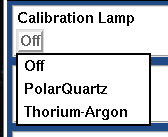Calibration Sources
A quartz lamp, usually called the 'polar quartz,' mounted on the wall opposite the slit, where the telescope's polar axle enters the slit room, provides a continuum source for flat fielding. When not in use, it is stowed to one side. Selecting the lamp from spectrograph motor control program hammotor_gui, automatically slides it into the lightpath and turns it on.
A thorium-argon hollow cathode line lamp for wavelength calibration is mounted above and behind the slit (additional lamps, such as iron or mercury, can be mounted if necessary - please consult a support astronomer well in advance of your run for availability and feasibility of installation). The arc lamp light is directed into the spectrograph via a turning mirror that slides into place above the slit when a line lamp is selected in hammotor_gui. hammotor_gui's lamp menu is shown in Figure 1. If a lamp appears to be weak or burned out, contact a member of the staff.
Figure 1: Lamp Selection Menu N.B. In order to protect expensive lamps, the light sources are on timers that will turn them off automatically after about 30 minutes. A lamp timer is displayed in hammotor_gui (see Figure 2) and may be reset to 1800 seconds by pressing the circular arrow icon. Please turn off lamps when you are finished using them.

Figure 2: Lamp Timer GUI
Support Astronomers (sa@ucolick.org) Last modified: Wed Feb 22 17:53:00 PST 2012